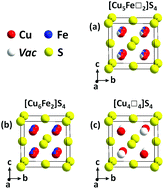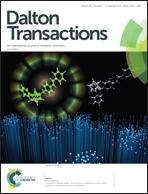The crucial role of selenium for sulphur substitution in the structural transitions and thermoelectric properties of Cu5FeS4 bornite†
Abstract
Bornite Cu5FeS4−xSex (0 ≤ x ≤ 0.6) compounds have been synthesized, using mechanical alloying, combined with spark plasma sintering (SPS). High temperature in situ neutron powder diffraction data collected on pristine Cu5FeS4 from room temperature up to 673 K show that SPS enables the stabilization of the intermediate cubic (IC) semi-ordered form (Fm![[3 with combining macron]](https://www.rsc.org/images/entities/char_0033_0304.gif) m, aIC ∼ 10.98 Å) at the expense of the ordered orthorhombic form (Pbca, aO ∼ 10.95 Å, bO ∼ 21.86 Å, cO ∼ 10.95 Å) in the 300–475 K temperature range, whereas above 475 K the IC form coexists with the high temperature cubic (C) form (Fm
m, aIC ∼ 10.98 Å) at the expense of the ordered orthorhombic form (Pbca, aO ∼ 10.95 Å, bO ∼ 21.86 Å, cO ∼ 10.95 Å) in the 300–475 K temperature range, whereas above 475 K the IC form coexists with the high temperature cubic (C) form (Fm![[3 with combining macron]](https://www.rsc.org/images/entities/char_0033_0304.gif) m, aC ∼ 5.50 Å). The ability of Se for S substitution to induce disorder and consequently to enhance the IC phase formation is also emphasized. This disordering effect is explained by the high quenching efficiency of the SPS method compared to conventional heating. The existence of topotactic phase transformations, as well as Se for S substitution is shown to have a significant effect on the transport properties. As expected, electrical transport properties indicate a change towards a more metallic behaviour with increasing Se content. The electrical resistivity reduces from ∼21.4 mΩ cm for the pristine Cu5FeS4 to ∼3.95 mΩ cm for Cu5FeS3.4Se0.6 at room temperature. A maximum power factor of 4.9 × 10−4 W m−1 K−2 is attained at 540 K for x = 0.4 composition. The influence of selenium substitution on the carrier effective mass and mobility is discussed based on single parabolic band approximation. Furthermore, a detailed investigation of the thermal conductivity by this isovalent anion substitution reveals a significant reduction of the lattice thermal conductivity due to the alloying effect. Finally, the important role of structural transitions in the thermoelectric properties is addressed. A maximum ZT of 0.5 is attained at 540 K for Cu5FeS3.8Se0.2 composition.
m, aC ∼ 5.50 Å). The ability of Se for S substitution to induce disorder and consequently to enhance the IC phase formation is also emphasized. This disordering effect is explained by the high quenching efficiency of the SPS method compared to conventional heating. The existence of topotactic phase transformations, as well as Se for S substitution is shown to have a significant effect on the transport properties. As expected, electrical transport properties indicate a change towards a more metallic behaviour with increasing Se content. The electrical resistivity reduces from ∼21.4 mΩ cm for the pristine Cu5FeS4 to ∼3.95 mΩ cm for Cu5FeS3.4Se0.6 at room temperature. A maximum power factor of 4.9 × 10−4 W m−1 K−2 is attained at 540 K for x = 0.4 composition. The influence of selenium substitution on the carrier effective mass and mobility is discussed based on single parabolic band approximation. Furthermore, a detailed investigation of the thermal conductivity by this isovalent anion substitution reveals a significant reduction of the lattice thermal conductivity due to the alloying effect. Finally, the important role of structural transitions in the thermoelectric properties is addressed. A maximum ZT of 0.5 is attained at 540 K for Cu5FeS3.8Se0.2 composition.



 Please wait while we load your content...
Please wait while we load your content...